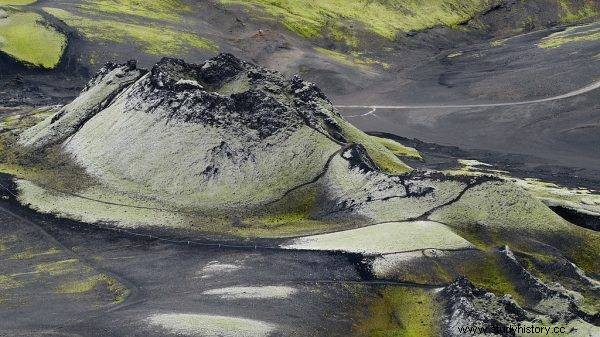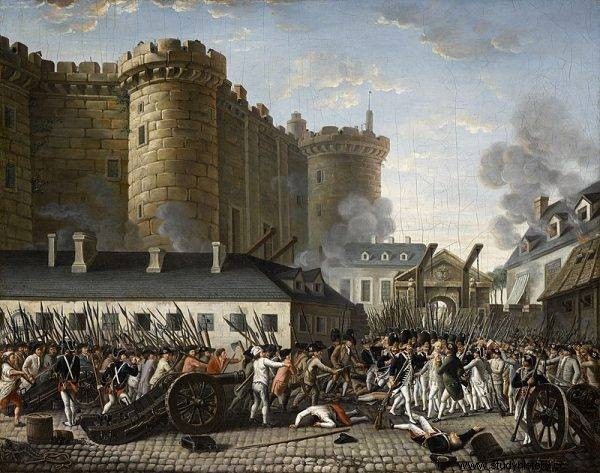We will never know the exact number of victims of Lakagígar volcano. The outbreak caused a dramatic cooling of the climate and resulted in the deaths of 5-6 million people.
In the summer of 1783, those who live in the south of Iceland must think that Ragnarök has arrived. That the day of judgment awaits at their gates, and the gates to the land of the dead are opened. Before all this is over, one fifth of Iceland's population will pass through those gates. Ultimately it will lead to famine in Finland, Sweden and elsewhere as well - Egypt, for example, will lose one sixth of its population to extreme weather caused by incidents in Iceland. In France, it will contribute to the general poverty which, six years later, will lead to the French Revolution.
Killer Icelandic volcano
On Pentecost Sunday, June 8, volcano opens Lakagígar - a twenty-five kilometer rift in the Earth's crust between the Vatnajökull and Mýrdalsjökull glaciers in the south of the island. Lakagígar is like a long, open wound in the globe's breast that bleeds profusely with fire. Giant lava fountains soar more than 1,000 meters into the sky . Lakagígar was named after the Laki volcano in its central part, but the volcano itself did not participate in the 1783 eruption.
The Rift runs from the southwest to the northeast and includes 135 individual craters. It is part of the volcanic system, including the Katla volcano, one of the largest in Iceland. The eruption that Icelanders call Skaftáreldar (from the river Skaftá) lasts eight months. By its end, one fifth of Iceland's population and almost three-quarters of its cattle will lose their lives. Icelanders refer to this period as Móðuharðindin (which roughly means "defeat of the fog").

On Pentecost Sunday, June 8, the Lakagígar volcano opens.
The effects of the Lakagígar outbreak are not limited to Iceland. Its dramatic consequences for the rest of the globe are slowly becoming apparent in the form of "volcanic winter". The veil of fumes - to put it bluntly - brings miserable weather, severe crop failures and severe cold winters to the world. The sulfur dioxide molecules released into the atmosphere by this type of explosion attract the water molecules. This is where the tiny droplets come from, which in turn creates a cloud much whiter than usual, reflecting more incoming sunlight than normal. If an eruption is strong enough, it clearly affects and cools the global climate.
Death Fog
This was the case after the Lakagígar eruption, when the average temperature on Earth drops by about one degree. Earlier, the deadly fog of Laki also comes. Unfortunately, the eruption coincides with unusual weather conditions:this is probably when the strong El Niño phenomenon occurs in the Pacific Ocean. There is also a high pressure area above Iceland. This makes the wind brings a thick and corrosive fog saturated with sulfur and fluorine over Western Europe . This caused immense suffering and death to thousands of people by the end of 1783.
Due to the low pressure on the Norwegian coast, the Laki fog first heads towards northern Scandinavia. From there it then goes south and slowly west:Prague on June 17, Berlin on June 18, and Paris on June 20. Britain becomes foggy on June 23.

The text is an excerpt from Marcus Rosenlund's book "When the weather changes the course of history", which has just been published by the Jagiellonian University Publishing House.
Many find it extremely painful: breathing sulfur dioxide vapors is a common cause of suffocation because when the gas reacts with the moisture in the lungs, sulfuric acid is formed and the tissues swell. According to some estimates in Great Britain, 23,000 people died this way in 1783 . Ships stay in ports because there is no way to navigate with almost zero visibility. The sun seems to shine behind the curtain of fog, but it is dim, blood red, and emits a dark, rusty light. It looks especially ominous during sunrise and sunset. The summer of 1783 is the hottest summer in Europe since time immemorial. There are strong thunderstorms with lightning and hail so great that - according to contemporary sources - the cattle fell on the fields from the blows. This ominous weather lasts until the fall when the fog finally clears.
Cold winter after record hot summer
Natural history specialist Gilbert White, who lived in Selborne, southern England, notes that the heat of the summer was so great that the meat from the slaughterhouse was barely eatable the day after the animal was killed. Then comes a very cold and cold winter. In Great Britain alone, around 8,000 people die of cold .
Inventor, scientist and writer Benjamin Franklin, then serving as the US ambassador to France, notes that sunlight weakened by dry fog is not enough to warm the earth's surface. As a result, the first autumn snow is deposited, which additionally cools the air and brings with it further snowfall. Franklin draws a specific conclusion:this fog originates in Iceland, but his suspicions fall on the volcano Hekla, which is de facto not involved this time. Hekla broke out several years earlier in 1766.

Benjamin Franklin notes that sunlight weakened by dry fog is not enough to warm the earth's surface.
The effects of the Lakagígar eruption are also on the other side of the Atlantic. On the east coast of the United States, the average temperature drops by 4.8ºC. The southern states are plagued by a severe snowstorm. In New Orleans, the ice covers the Mississippi River, and there is a country on the Gulf of Mexico.
Severe hunger in Europe
In Scandinavia, people are hit hard by the cold caused by the Lakagígar eruption. Finland suffers from great famine in 1783-1784, and the situation in Sweden is not much better. The historian Carl Grimberg writes in 1921 in Svenska folkets underbara öden about the "severe famine of 1783–1784". He notes that the winter of 1783–1784 was extremely severe and in March "the roads were so covered with snow that it was almost impossible to ride them on horses and carriages" . At sea, ice remained until May, and on lakes even until June.
In France, severe droughts, heavy rainfall and hailstorms that alternate over several years destroy crops. In 1783 and in the following years, hunger rages there and poverty increases significantly because of lack of food. , which contributed to the outbreak of the French Revolution in 1789.

In France, severe droughts, heavy rainfall and hailstorms that alternate over several years destroy the crops. Hunger contributes to the outbreak of the French Revolution.
The final balance of the Lakagígar volcano eruption, including indirect casualties, will never be known. The fact is, however, that the eruption has caused a dramatic and long-lasting global cooling of the climate, especially in the Northern Hemisphere. It also weakened the monsoons in North Africa, the Arabian Peninsula and India. No less than 5-6 million people can be considered dead from these extreme weather events . Thus, the Lakagígar eruption is the most destructive volcanic eruption in modern times.
Could something similar happen today?
No doubt, says the Icelandic seismologist Reynir Böðvarsson when I interviewed him on behalf of the Svenska Yle TV station in early 2010. As the climate warms, the risk has even increased. Due to global warming, Iceland's glaciers have shrunk considerably in volume and weight in recent times, explains Böðvarsson. This means that there is less stress on the earth's crust and it does not take as much pressure from the underground magma as before for an explosion to occur.

In Europe, we do not realize how great a risk a large volcanic eruption in Iceland can pose (illustrative illustration).
Böðvarsson also claims that we in Europe do not realize how great a risk a large volcanic eruption in Iceland can carry for us , and believes that it is difficult to reach politicians with this, because they place a human measure of time on geological phenomena. That is, if something like this has not happened in three generations, it will not happen again - which is not true. According to the geological flow of time, 1783 was almost yesterday. However, it is very difficult for people to understand this, especially in relation to great and rare events. This is a huge danger. The small 2010 Eyjafjallajökull volcano eruption that disrupted air traffic for a week was nothing compared to what would happen if there was a really large eruption in Iceland, warns Böðvarsson.
Source:
The text is an excerpt from Marcus Rosenlund's book "When the weather changes the course of history", which has just been published by the Jagiellonian University Publishing House.

